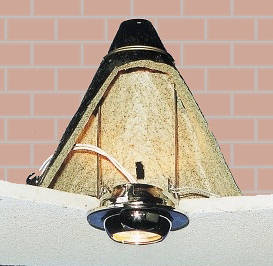
These are used to maintain the fire rating of a ceiling. When a fire occurs, the heat causes the intumescent material which lines the hood to expand and fill the void between the lamp and the hood. This seals any gap in the ceiling and therefore maintains the fire rating of the ceiling.
These hoods are not required in most domestic house situations. If the ceiling is in a flat and there is another flat above you, you must use fire hoods. If for some bizarre reason you are fitting halogens in a garage with a habitable room above, you must also use these hoods. As far as i know, these are the only COMMON circumstances which require the maintenance of fire rating of ceilings in domestic situations.
Where fire rating is not required, and you simply need to keep insulation at bay, an MDF box, clay flowerpot, or any sort of enclosure you can make yourself from relatively heat-proof material, will be cheaper and allow the lamps to dissipate heat better than a fire hood. Suggested sizes are 6-10 inches square and 8-12 inches high. Some say you should drill a couple of holes in the top for heat dissipation (hence the flowerpot suggestion!), but if the lights are fitted in a bathroom or kitchen this should not be done, and flowerpots not used, as you need to prevent the moist air from the room entering the unconditioned roof space where it will cause condensation which will damage the roof.
Building and wiring regulations require breaches of a fire barrier to be replaced by materials that will maintain the integrity of that barrier in the event of a fire. Firehoods are designed to cover the luminaire and provide adequate ventilation and protection in normal use. Under fire conditions, the intumescent coating closes over to seal the luminaire aperture.